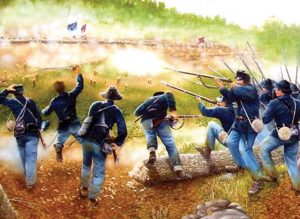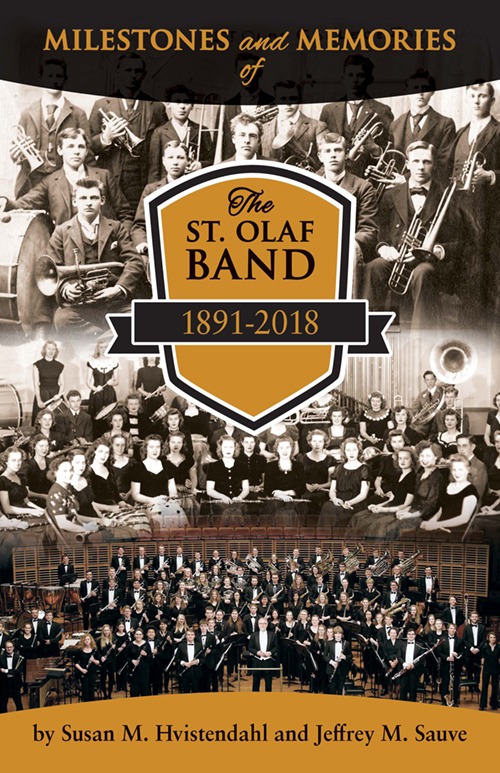 From February 2007 to December 2016, I wrote 119 “Historic Happenings” columns for The Entertainment Guide. What have I been doing since my last column? I would like to say I have been traveling the world and, in a way, I have been, moving through time and space historically with the St. Olaf Band. Now, I am pleased to announce that By All Means Graphics (which publishes The Entertainment Guide) is the publisher of a book that Jeffrey M. Sauve co-authored with me.
From February 2007 to December 2016, I wrote 119 “Historic Happenings” columns for The Entertainment Guide. What have I been doing since my last column? I would like to say I have been traveling the world and, in a way, I have been, moving through time and space historically with the St. Olaf Band. Now, I am pleased to announce that By All Means Graphics (which publishes The Entertainment Guide) is the publisher of a book that Jeffrey M. Sauve co-authored with me.
I played alto clarinet in the Band, including a 1966 concert tour of Germany, Denmark and Norway, so I always felt a special connection to the Band during the many hours of research and writing this 600-page history of the ensemble. Sauve, who was associate archivist at St. Olaf, ably handled the early Band years, 1891-1957, and I was fortunate to elicit firsthand information about the years 1957-2018 from Myrna Johnson, wife of my Band conductor, Miles Johnson, from his successor Timothy Mahr, and from many Band members, past and present, who were eager to share their experiences with me.

Now I am going to share with you, in this 120th (a nice round number) and last column, some of the history of the St. Olaf Band (to inspire you to read the book, of course). Sauve wrote about the humble beginnings of the St. Olaf Band when a few young men formed the St. Olaf College Cornet Band in the southwest tower room of Old Main on Oct. 5, 1891, at a time when there were only 184 students enrolled. (Sauve uncovered a gem of a story in a Norwegian newspaper alleging that the instruments were obtained when Carleton boys declined to blow horns given them by the town band for fear it would “disfigure the boys’ nice facial features.”) By June of 1893, the Band played the first outdoor concert at Northfield’s City Park and the next year, on May 17, the Band “flooded the city with sweet music” from the roof of Old Main – during the very early hours of 4 and 6am.
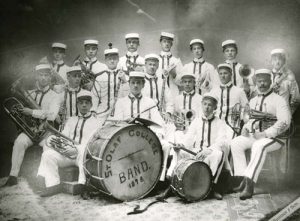
On April 29, 1898, the “Boys in White” (so-named because of their white uniforms, trimmed with black braid and brass buttons) sent off recruits for the Spanish-American War from the Northfield train station, joined by a crowd of 2,000. (In subsequent years, they became known as the Boys in Gray and the Boys in Black as they donned new uniforms.) By 1899, the Band was warmly praised by the Northfield News: “Northfield has many things to be proud of and foremost among these is the St. Olaf College Band.” The shift from a brass band to a concert band had been started under former student leader and clarinetist Andrew Onstad, who was hired by the College as a paid music instructor in 1900.

F. Melius Christiansen was named head of the newly formed Music Department in 1903. He was a native of Norway who had emigrated in 1888 and had built a reputation in the Twin Cities as a violin player, composer and conductor. Christiansen instilled discipline in the Band, whose members had simply enjoyed playing marches and waltzes for their own entertainment, without thoughts of tone quality. By the end of the school year, he was hailed for having put together a music festival that brought in 1,000 visitors.
Sauve gives insightful details of the early Band tours, which started under Christiansen with mishaps of management and weather in mid-January of 1905. That May, a student chorus from Oslo visited St. Olaf, which inspired Christiansen to take the 48-member Band to his native country in the summer of 1906. It was the first American collegiate instrumental music organization to tour abroad. Crossing the ocean on a steamship in steerage turned out to be a difficult experience, with seasickness, “petrified feather pillows” and wretched food, but once in Norway, the Band enjoyed an enthusiastic welcome. They played 26 concerts with 62,000 listeners and at one point traveled on an 800-ton luxury boat along the western coast of Norway. Students demonstrated the first baseball game ever played in Norway (deemed “too dangerous” by spectators) and initiated bridge-building between the two countries, while connecting with Norwegian relatives.
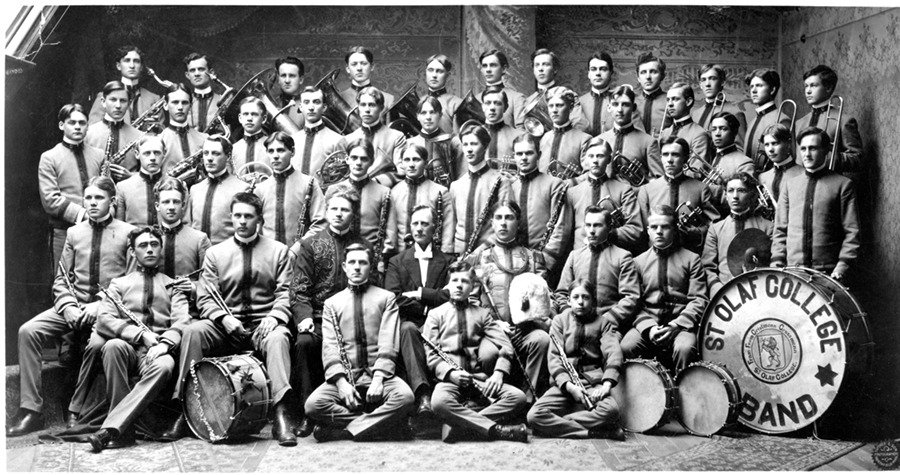

Then, in 1909, the Band took an adventurous 12-week tour to the 1909 Alaska-Yukon-Pacific Exposition in Seattle as the only college ensemble invited. The Band traveled mostly by rail more than 5,000 miles, playing 100 concerts in 69 cities and towns, culminating in leading a mile-long parade to celebrate Norway Day on Aug. 30.
In the fall of 1919, the Band was turned over to Johan “Jack” Bergh, freeing Christiansen to devote more time to the St. Olaf Choir, which he founded in 1912. Klara Overby (cornet) and Clara Duea (French horn) became the first females in the Band in the 1920-1921 season. Sauve relates that Bergh instituted his preferred presentation style of performing concerts from memory, which received wide acclaim. Christiansen briefly led the Band again 1933-1937. During World War II, with men in the military, women took over the concert Band. After the war, Donald Berglund became conductor of the Band and the Orchestra and Bruce Howden took over the Band from 1952 to 1957.
Miles “Mity” Johnson led the Band from 1957 to 1994. Under Johnson, the Band was restored to its glory days under Christiansen and once again performed to worldwide audiences. Olaf Christiansen, son of F. Melius and head of the Music Department at St. Olaf, recruited Johnson from Hawley, Minn., where he was handling all grades in music. Johnson requested a yearly Band tour and, after building up the Band and a succession of Midwestern tours, approval was given for a 60th anniversary tour of the 1906 tour that F. Melius Christiansen had led to Norway, now adding stops in Germany and Denmark in June of 1966. (The Band had not toured internationally since 1906.)
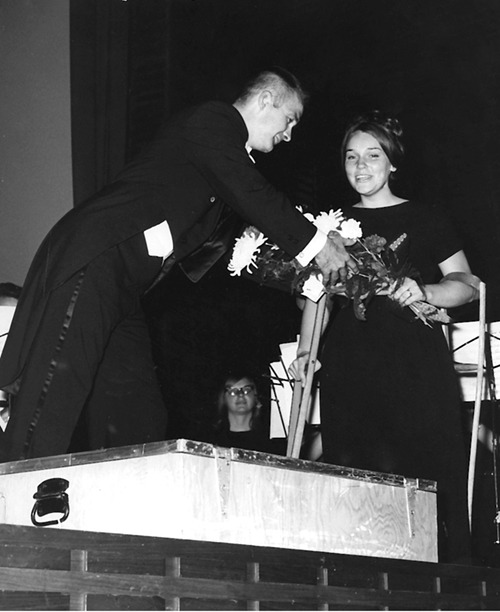
Our 77-piece Band covered 8,000 miles and gave 27 concerts in 30 days in parks, cathedrals, concert halls and music festivals, having prepared 15 major works, 12 marches, American folk music, excerpts from 10 Broadway shows, other solo and ensemble works and national songs of host countries. Composer Egil Hovland of Norway was commissioned to write Fanfare and Choral specifically for the Band. He said that our performance was “like being lifted up to heaven.” Irene Gubrud ’66, flute/piccolo player, received multiple ovations as soprano soloist throughout the tour. Gubrud (who went on to a distinguished career in New York) told me recently, “Performance after performance we were all totally immersed in the joy of making music with each other. Our own hearts were filled to the brim as we also so enjoyed the audience’s enthusiasm!” I had written my folks that the first audience in Trier, Germany, “clapped and stomped like mad.” Among highlights: the Band was televised throughout Germany as we cruised down the Rhine River, featured during the prestigious Bergen Musical Festival, had a boat tour of the fjords, performed at the University of Oslo and in the Nidaros Cathedral of Trondheim and was the main attraction at the North Norway music festival in Harstad, where we outdrew the Oslo Philharmonic.
We were all quite proud that our tour paved the way for trips abroad, which have continued for St. Olaf Band members ever since.
The next international tour was to Europe in 1970, with the Band featuring Music for Prague 1968, Karel Husa’s powerful response to the Soviet Union’s invasion of Czechoslovakia. In the 1970s the Band began to add theatrical, multi-media elements after intermission, showing the influence of Johnson’s wife, Myrna, who had been one of the founders of the Northfield Arts Guild in 1959. “Window on America” from 1970 included trombones marching down the aisle, folk singing and slides of American scenes as the Band played the theme from “2001: A Space Odyssey.” “An Afternoon in the Park” in 1975 found Band members wearing old-fashioned capes, singing, dancing and playing marches, waltzes, ballads and show tunes.
A concert outside the firebombed Coventry Cathedral in England during a 1974 College Centennial tour of Norway and Great Britain inspired Johnson to initiate a series of Cathedral Concerts in the Twin Cities in 1975, which ended in 2003. Another tradition began in 1974: the highly anticipated annual spring Broken Bat softball game between the Band and Orchestra. The Band prevailed 24-5 at the first match. Yet another milestone was Johnson’s formation of the Twin Cities Adult Band (later called the Minnesota Symphonic Winds), with a first performance at the St. Olaf College Band Festival on May 5, 1979.
Timothy Mahr ’78 was among the Band members who took a 1977 Interim course in the history of the British wind band in England. The crowning event was “Massed Bands in Concert – Bands and Trumpeters of the Royal Military School of Music with St. Olaf Band-Minnesota USA.” In 1980 another London Interim included Band members being part of the finale at Royal Albert Hall in Beethoven’s Wellington’s Victory. There was one last Interim in London in 1984 and a 10-concert tour of the British Isles in the summer of 1991.
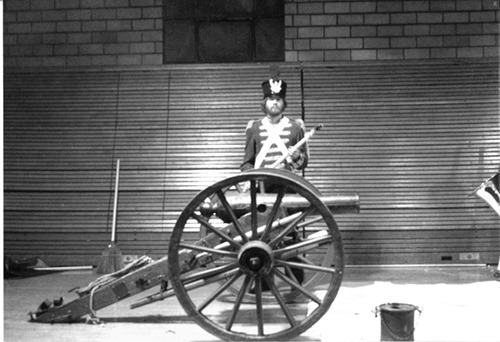
Mahr loves to recount the Midwest tour of his senior year when the theme of “A Tchaikovsky Evening” reached its climax with explosives from a Civil War-era cannon brought along for the 1812 Overture. Percussionist Stephen Bergen handled the gunpowder and lighting of the fuse, while Dave Halvorson shot 12-gauge blanks into an oil drum. In Harlan, Iowa, the fire alarm blared away and at the home concert, Bergen gave an extra dose of gunpowder, filling Skoglund with a cloud of gray smoke.
A couple events took place in St. Paul: a 1981 concert at O’Shaughnessy Auditorium and a sold-out joint concert in 1986 with the bands from Concordia College and Luther College at the Ordway Music Theater (repeated in 1991). Then, in 1987, the Band was selected to perform before the College Band Directors National Association convention in Evanston, Ill., on Feb. 26. The first half featured works of Minnesota composers (including Mahr’s Fantasia in G) and the second half was called “From Our Scandinavian Heritage,” with student conductors and musicians encircling the audience, playing and singing a medley of Norwegian songs. The CBDNA president, Donald Hunsberger, later wrote Johnson, “The use of the band as a choir was so expressive and really provided a wonderful finale to your concert.” The Band then took this program to Norway, with the first concert at the famed Bergen Music Festival on May 28.
The winter of 1990 found the Band touring south, with receptive crowds in cities such as Memphis, Nashville, Atlanta and St. Louis. The Band was joined in May of 1991 by 260 alumni for a reunion concert to celebrate the centennial of the Band. Participants on the fall tour of the Dakotas in 1991 will never forget the Halloween blizzard which led to consternation and cancellations.
On Jan. 5, 1994, Timothy Mahr, associate professor of music at the University of Minnesota Duluth, was named the new conductor of the St. Olaf College Band with Johnson’s retirement. One last tour under Johnson took the Band east as far as Pennsylvania and Maryland. A recognition banquet was held at the Minneapolis Convention Center and the Band, Choir and Orchestra presented a concert at Orchestra Hall in Minneapolis on April 17, where Johnson led 250 participants in selections from Carl Orff’s 1937 oratorio Carmina Burana at the end of the program.An alumni reunion band took part in the last concert on May 21 before Commencement. In May of 2004, 450 past and present Band members gathered for another Commencement concert but Johnson, who had been diagnosed with Alzheimers in 1998, could not join them and died at the age of 75 on Aug. 26.
Looking back, Mahr said, “Mity built up a program here that is internationally renowned. Of course, he had help from a few fellow faculty members, but he basically built it himself. He helped people realize that the concert band stands toe to toe with the choral and orchestral traditions. He liked to be as artistic as possible with band music, and he was very good at sharing it with people.”
 Mahr, now in his 26th year as conductor at St. Olaf, has continued to build up the Band. Mahr accompanied friends from Wisconsin on a school visit to St. Olaf, was blown away by seeing a concert and enrolled in 1974. Mahr played trombone (which he insists is “God’s instrument”) and was vice president of the Band his senior year. Before returning to his alma mater as conductor, Mahr taught music in Milaca, Minn., did graduate work at the University of Iowa and was director of bands at the University of Minnesota Duluth. Mahr and Jill Erickson, a Duluth native and UMD flute player, married in 1987. During his time at UMD, Mahr not only strengthened the band program but founded the Twin Ports Wind Ensemble and was awarded the American Bandmasters Association/Ostwald Award for his composition The Soaring Hawk. After a national search, Mahr was chosen as the successor to Johnson and a new era for the Band began.
Mahr, now in his 26th year as conductor at St. Olaf, has continued to build up the Band. Mahr accompanied friends from Wisconsin on a school visit to St. Olaf, was blown away by seeing a concert and enrolled in 1974. Mahr played trombone (which he insists is “God’s instrument”) and was vice president of the Band his senior year. Before returning to his alma mater as conductor, Mahr taught music in Milaca, Minn., did graduate work at the University of Iowa and was director of bands at the University of Minnesota Duluth. Mahr and Jill Erickson, a Duluth native and UMD flute player, married in 1987. During his time at UMD, Mahr not only strengthened the band program but founded the Twin Ports Wind Ensemble and was awarded the American Bandmasters Association/Ostwald Award for his composition The Soaring Hawk. After a national search, Mahr was chosen as the successor to Johnson and a new era for the Band began.
Mahr relied on Band officers to help run the Band during 1994-1995, saying, “I had a Lamborghini. I didn’t need to get under the hood and start tinkering with anything.” The first tour in the winter of 1995 was to northern Minnesota, Wisconsin and Michigan with the theme “Commemorating the 50th Anniversary of the End of World War II,” with narration by Band members. The musical numbers evoked strong emotions in the audience, bringing some to tears. Mahr was assessed by Band president Rachel Westermeyer as commanding respect, and being “Quick-witted, sharp and funny.”
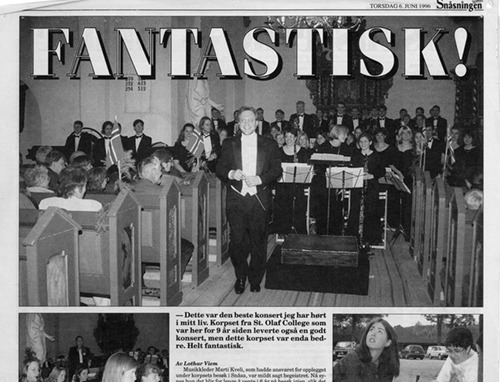
The next year brought Richard Erickson ’66 in as Band manager, a performance for royal visitors King Harald V and Queen Sonja of Norway in October, a new tradition of cookie baking at the Mahr home for the holidays and a 1996 tour “Celebrating the Classics” to seven Midwestern states. (Mahr was called an “internationally acclaimed composter” by a newspaper in Wisconsin which he described as some of the “finest press” he had ever received.) The year climaxed with a tour to Norway after Commencement.
In 1996, a tie-dye party was added to the usual activities of a fall picnic, hayride and cookie baking, in anticipation of the Band’s California tour of 1997. The Band was one of just four bands chosen to perform for the American Bandmaster Association in San Diego and premiered Faith by rising young composer Andrew Boysen Jr. on March 6. Another honor came when the Band was chosen from more than 70 applications for an appearance at the Minnesota Music Educators Association Mid-Winter clinic at the Minneapolis Convention Center in 1998, following a “Big Sky” tour.
The prolific Minnesota composer Stephen Paulus was commissioned to write his first band work for the Band’s 2000 winter tour. The Band gave the world premiere of Over One Hundred Years: A Celebration of the St. Olaf Band during a pre-tour concert at Apple Valley High School, with Paulus in attendance. The 125th anniversary of St. Olaf’s founding was also celebrated in March of 2000 in a showcase of the Band, Choir and Orchestra in Orchestra Hall in Chicago and in Minneapolis. A tour of Britain and Ireland capped off that school year.
In 2001, the Band was starting rehearsals for David Maslanka’s Symphony No. 5 for a fall tour when the unthinkable happened: the terror attacks on Sept. 11, 2001. Mahr said throughout the country his colleagues turned to music-making as a “healing balm.” Maslanka came to St. Olaf from Montana the first couple days in October to help with the 40-minute work and then attended three of the Band’s concerts in Montana. He later wrote, “The band did amazing work and has won a place in my heart. It was a huge mountain and they scaled it with grace and good hearts.” Also on the program was Mahr’s Mourning Dances, created in the wake of the devastating loss of three St. Olaf students in a car crash the previous March, including Band clarinetist Christopher Hoppe. All in all, it was an emotional time for the close-knit Band.

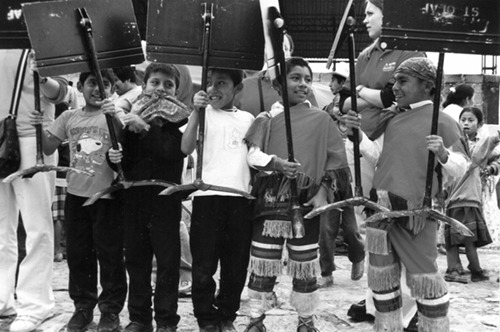
The 2003 winter tour to the East celebrated the establishment of the College Music Department under F. Melius Christiansen in 1903, with two world premieres by Minnesota composers Mary Ellen Childs (Zephyrus, her first work for band) andLibby Larsen (Strut). The high point of the tour was a concert on Feb. 5 at Alice Tully Hall in New York City’s Lincoln Center. The New Yorker described Childs and Larsen as “two tireless Midwest innovators” and the St. Olaf Band as “one of America’s preeminent bands.”
You will find that the story of the Band’s Interim study/tour of Mexico in January of 2004 is an amazing tale. In addition to presenting concerts, the Band had collected instruments and other equipment to help the small mountain town of San Miguel Tzinacapan start a youth band. One complication on this tour came when a truck was held up briefly at the border, and the Band had to borrow some instruments for the first concert in Guanajuato, even a sousaphone held together with duct tape. At the end of the tour, many Band members had gained an appreciation of another culture, one of the aims of foreign travel.
The Band under Mahr, Choir under Anton Armstrong and Orchestra under Steve Amundson gave a joint concert for the national conference of the National Association for Music Education in Minneapolis in April of 2004 after all had won an unprecedented “best in class” distinction in blind audition tapes. Then, in June of 2005, these three elite ensembles journeyed together to Norway for joint and separate concerts for the first time, acknowledging the special ties between the College and Norway. Mahr said he was amazed at the experience of touring with six busloads of musicians, who grew in respect for each other while performing in world-class concert sites.

New Band manager Terra Widdifield ’95 helped smooth the way for the next international tour for the Band, the 2010 Interim study/tour of Japan, another remarkable story. Japanese students lined up for hours to meet the Band and audiences responded enthusiastically, especially appreciating that Clifton Nesseth ’10 had learned to play the Japanese shakuhachi, an end-blown flute.The Band members were visibly shaken by a visit to Hiroshima and were impressed at a school as they watched 300-pound Sumo wrestlers and diligent student musicians in three-hour rehearsals. They relaxed at the end of the tour in open-air hot spring baths at a ryokan. One of the hosts later wrote approvingly of the “fine Americans” who had reset his mind about “ugly Americans.”

Yet another honor came to the Band when it was the only liberal arts college selected to perform at the College Band Directors National Association national conference in North Carolina in March of 2013. In 2014 the Band was off again, this time to Spain, France and Italy. Among other concerts, the Band was the first American ensemble to perform in the Darius Milhaud Conservatory in Aix-en-Provence and opened the summer festival in Pavia, Italy. Again, Band members reflected on how the tour had opened their hearts to other cultures.
Just imagine what awaited first-year students who made it into the St. Olaf Band in 2014 and played all four years. In the fall of 2014, they would fly out to start a “Mostly British” fall tour with the Las Vegas Academy Wind Ensemble, perform at Carnegie Hall in 2016, escape the Minnesota cold with a winter tour to Florida in 2017 and enjoy a January Interim tour in 2018 to New Zealand and Australia. Not bad.
To celebrate the 125th anniversary of the St. Olaf Band in 2016, David Maslanka was commissioned to write Angel of Mercy for the Band to premiere on the winter tour to the East, which would culminate in the first-ever appearance Feb. 6 at Carnegie Hall in New York City. Maslanka later wrote, “The Carnegie concert was triumphant. An audience of more than a thousand gave a prolonged standing ovation for Angel of Mercy. It was a highlight moment in my life to receive that applause.” (After the tour, Maslanka was awarded an honorary doctorate from St. Olaf. He died of colon cancer on Aug. 26, 2017, at the age of 73.) The Band book goes into detail about this performance, which concluded with an encore of Gershwin’s Strike Up the Band, with a strain of Um! Yah! Yah! inserted into the piece, guaranteed to evoke a reaction from Oles in the audience.
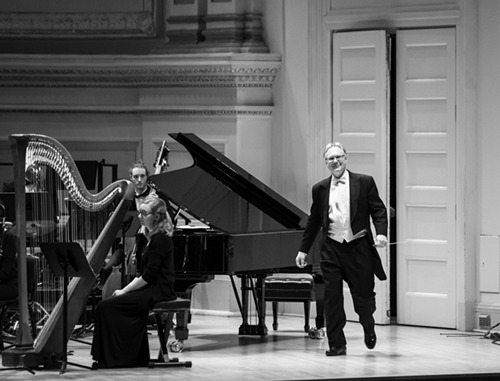
The Band prepared for the 2018 Interim abroad with rehearsals and classes about their destination. They left for New Zealand on Jan. 15 and within days were transported to The Shire (the Hobbiton movie set of the Lord of the Rings film series) and to Tamaki Village in the Rotorua forest to learn about the customs and traditions of the Maōri people. Innovative Australian composer Jodie Blackshaw met the group in Australia and charmed the Band as she worked with them on her composition Twist (forget Chubby Checker, the title refers to the twists of the Murray River). The Band’s final concert was held at the Sydney Conservatorium of Music, after a tour of Sydney’s Opera House.
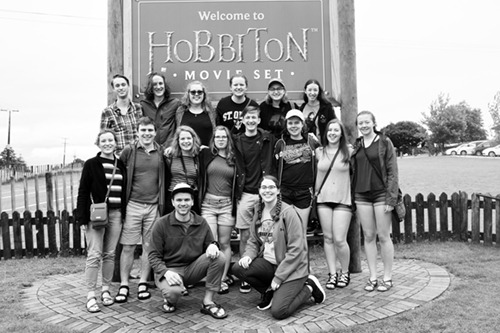
The Band history book concludes with Mahr’s reflection that the Band is “on a nice ascendant path of deeper understanding and stronger musicianship.” He attributes this to the entire faculty and staff of St. Olaf that create the total experience on campus that “changes the students into people who are ready to launch into their lives.”
My final thought is that along with the many musical milestones in the Band’s history from 1891 to 2018, and beyond, it is the memories of friendships that we who have been in the Band carry with us that resonate most deeply. As Mark McCrady ’97, director of Bands for the Whitefish School District in Montana, told me, “I truly believe that the community fostered in the St. Olaf Band was what set it apart and helped create such a cohesive, warm band sonority. People who care about each other make great music together.”
Milestones and Memories of the St. Olaf Band and three Historic Happenings books can be found at By All Means Graphics, the Northfield Historical Society and ordered from ByAllMeansGraphics.com/books.



